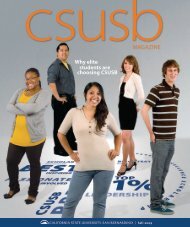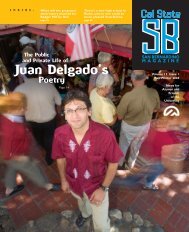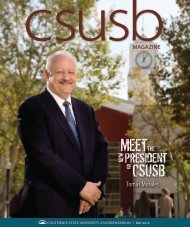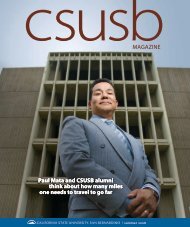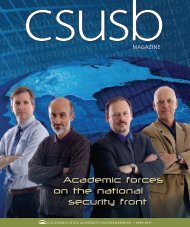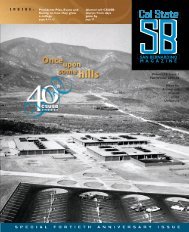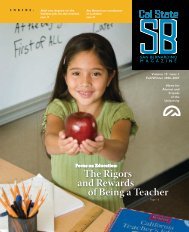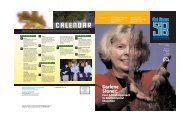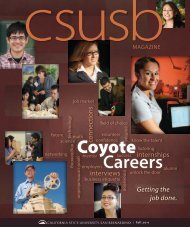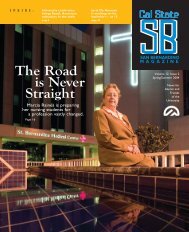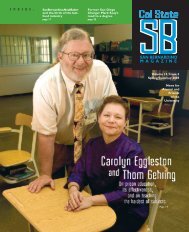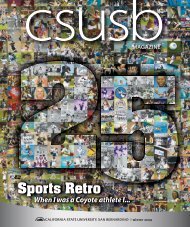Insights into the Ancient, the Contemporary Insights into the Ancient ...
Insights into the Ancient, the Contemporary Insights into the Ancient ...
Insights into the Ancient, the Contemporary Insights into the Ancient ...
You also want an ePaper? Increase the reach of your titles
YUMPU automatically turns print PDFs into web optimized ePapers that Google loves.
Bernardino’s “ArtStop,” a<br />
public art project for which<br />
she earned a $500 commission.<br />
Her works have been<br />
displayed in numerous campus<br />
student exhibitions, including<br />
<strong>the</strong> Robert V. Fullerton<br />
Art Museum’s 36th Annual<br />
Student Exhibition, where<br />
her suburban night scene,<br />
“Clusters,” was given <strong>the</strong><br />
President’s Purchase Award.<br />
“She is extraordinarily<br />
focused in her work,” says<br />
Brad Spence, a CSUSB assistant<br />
professor of art. “Annabel<br />
has exacting standards for<br />
her hyper-realist works …<br />
and is unquestionably one of<br />
<strong>the</strong> most ambitious undergraduates<br />
I have had <strong>the</strong><br />
opportunity to teach.”<br />
Specializing in environmental<br />
critiques, and specifically in<br />
suburban <strong>the</strong>mes, she draws<br />
her creative and technical<br />
inspiration from artists such as<br />
Salvador Dali, and also favors<br />
contemporary environmental<br />
artists David Korty, Solomon<br />
Huerta and Bill Owens. From<br />
<strong>the</strong> Center of a Child’s Universe<br />
Welcome to <strong>the</strong> happiest place on campus.<br />
On Cal State San Bernardino’s west end in two spacious<br />
rooms, on any given weekday, children enjoy<br />
an “enhancement of <strong>the</strong> environment” or are o<strong>the</strong>rwise<br />
engaged in a curriculum of play that draws from<br />
<strong>the</strong> constructivist approach of Piaget and Vygotsky.<br />
Yes, Piaget and Vygotsky. Now, kids ages 3-12 who<br />
come to <strong>the</strong> Children’s Center at CSUSB really couldn’t<br />
give an owl’s hoot about Piaget and Vygotsky. At this point<br />
in life <strong>the</strong>y’re thinking more Yu-Gi-Oh!, Lego, Nabisco<br />
and Kraft. None<strong>the</strong>less, Piaget and Vygotsky fit snugly<br />
<strong>into</strong> <strong>the</strong> center’s belief – supported by mounting evidence<br />
– that children develop best when <strong>the</strong>y’re active,<br />
exploring and involved in <strong>the</strong> world around <strong>the</strong>m. This<br />
is what children like and need, and this is why CSUSB’s<br />
Children’s Center is <strong>the</strong> happiest place on campus.<br />
The Children’s Center provides a comprehensive<br />
educational program for children between<br />
<strong>the</strong> ages of 3 and 5 years old, and an after-school<br />
enrichment program for children ages 6-12.<br />
The center includes two preschool classrooms.<br />
One room has carpeted areas for quiet activities<br />
and stories, “housekeeping” areas for dramatic<br />
play, and tables for creativity and discovery.<br />
A fenced outdoor play area runs adjacent to <strong>the</strong> classrooms.<br />
The area is covered with wood chips and has paved<br />
bicycle paths for tricycles and wheeled toys. Sandboxes,<br />
water tables, climbing equipment, a basketball court,<br />
tire chips, and outside toys help develop <strong>the</strong> children’s<br />
motor skills. An outdoor art area promotes creativity.<br />
The Children’s Center is open from 7:30 a.m.-10 p.m.<br />
Monday-Thursday and 7:30 a.m.-6 p.m. on Fridays through-<br />
out <strong>the</strong> academic year.<br />
<strong>the</strong>ir work, she has gained<br />
insight <strong>into</strong> subject portrayal<br />
and critique and <strong>the</strong> perpetual<br />
search for beauty.<br />
This can be difficult in a<br />
region where tract housing<br />
abounds. Annabel uses words<br />
like “conformity” and “banality”<br />
to describe <strong>the</strong> suburban<br />
landscape. “But at <strong>the</strong> same<br />
time I critique <strong>the</strong> environment,<br />
I try to look for beauty<br />
in it,” she says. “I try to make<br />
it more interesting for myself.<br />
I add certain things.”<br />
By heightening color or<br />
introducing light, Annabel<br />
caters to <strong>the</strong> human need for<br />
beauty, meaning and hope<br />
beyond what is physically and<br />
visually present. At <strong>the</strong> same<br />
time, says Spence, her work<br />
has a “consistently unsettling<br />
mood.” The push and pull of<br />
<strong>the</strong>se dissonant elements is<br />
this painter’s visual and visceral<br />
commentary.<br />
Annabel’s goal is to<br />
become a gallery artist and<br />
fully support herself by selling<br />
her art. Although she realizes<br />
this is a lofty ambition,<br />
she believes that people make<br />
<strong>the</strong>ir own opportunities. “That<br />
means not letting anything get<br />
in <strong>the</strong> way of what you want<br />
to do, not giving up, not taking<br />
a defeatist attitude, having<br />
confidence in yourself, working<br />
… as hard as you possibly<br />
can to achieve your goals,<br />
never wavering.”<br />
Teresa Sinner is an intern in <strong>the</strong><br />
California State University, San<br />
Bernardino public affairs office.<br />
A communication studies major,<br />
she will graduate in December<br />
with her bachelor’s degree.<br />
25<br />
Spring/Summer CSUSB



